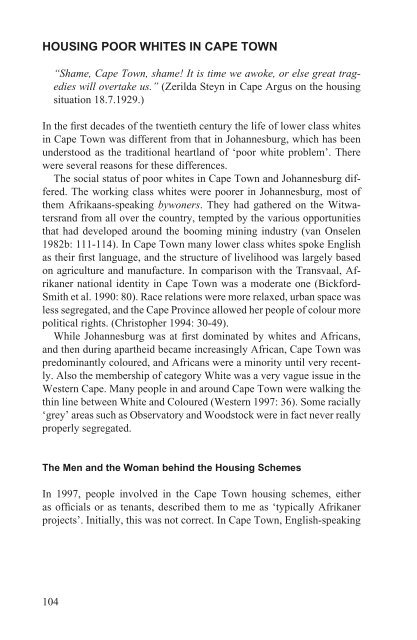The Making of a Good White - E-thesis - Helsinki.fi
The Making of a Good White - E-thesis - Helsinki.fi
The Making of a Good White - E-thesis - Helsinki.fi
Create successful ePaper yourself
Turn your PDF publications into a flip-book with our unique Google optimized e-Paper software.
HOUSING POOR WHITES IN CAPE TOWN<br />
“Shame, Cape Town, shame! It is time we awoke, or else great tragedies<br />
will overtake us.” (Zerilda Steyn in Cape Argus on the housing<br />
situation 18.7.1929.)<br />
In the <strong>fi</strong>rst decades <strong>of</strong> the twentieth century the life <strong>of</strong> lower class whites<br />
in Cape Town was different from that in Johannesburg, which has been<br />
understood as the traditional heartland <strong>of</strong> ‘poor white problem’. <strong>The</strong>re<br />
were several reasons for these differences.<br />
<strong>The</strong> social status <strong>of</strong> poor whites in Cape Town and Johannesburg differed.<br />
<strong>The</strong> working class whites were poorer in Johannesburg, most <strong>of</strong><br />
them Afrikaans-speaking bywoners. <strong>The</strong>y had gathered on the Witwatersrand<br />
from all over the country, tempted by the various opportunities<br />
that had developed around the booming mining industry (van Onselen<br />
1982b: 111-114). In Cape Town many lower class whites spoke English<br />
as their <strong>fi</strong>rst language, and the structure <strong>of</strong> livelihood was largely based<br />
on agriculture and manufacture. In comparison with the Transvaal, Afrikaner<br />
national identity in Cape Town was a moderate one (Bickford-<br />
Smith et al. 1990: 80). Race relations were more relaxed, urban space was<br />
less segregated, and the Cape Province allowed her people <strong>of</strong> colour more<br />
political rights. (Christopher 1994: 30-49).<br />
While Johannesburg was at <strong>fi</strong>rst dominated by whites and Africans,<br />
and then during apartheid became increasingly African, Cape Town was<br />
predominantly coloured, and Africans were a minority until very recently.<br />
Also the membership <strong>of</strong> category <strong>White</strong> was a very vague issue in the<br />
Western Cape. Many people in and around Cape Town were walking the<br />
thin line between <strong>White</strong> and Coloured (Western 1997: 36). Some racially<br />
‘grey’ areas such as Observatory and Woodstock were in fact never really<br />
properly segregated.<br />
<strong>The</strong> Men and the Woman behind the Housing Schemes<br />
In 1997, people involved in the Cape Town housing schemes, either<br />
as <strong>of</strong><strong>fi</strong>cials or as tenants, described them to me as ‘typically Afrikaner<br />
projects’. Initially, this was not correct. In Cape Town, English-speaking<br />
104
















